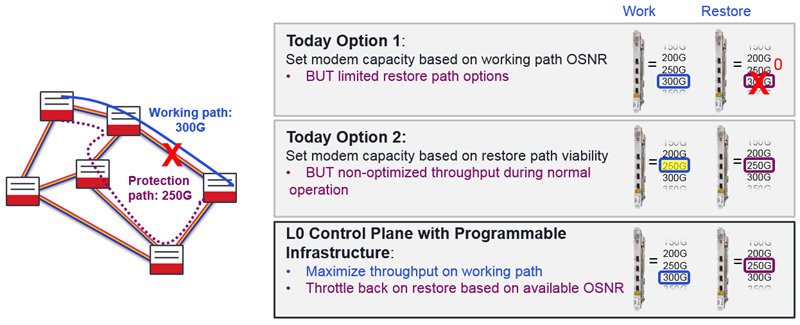How photonic control plane advancements are benefiting network operators
To achieve better business outcomes in this new world of over-the-top competition and demanding, connected users, providers are on a journey to realizing the Adaptive Network™. They are evolving their networks to a more programmable infrastructure that can scale and respond on demand to meet unpredictable traffic requirements. At the foundation of this programmable infrastructure is an agile, resilient photonic layer that will allow operators to maximize efficiencies through new levels of agility, increased automation and simplified operations.
As I explained in a recent blog, there is a growing need for a flexible grid, reconfigurable photonic layer foundation in next-gen networks – one that leverages the combination of the latest coherent technology and a CDC-F ROADM infrastructure with increased automation to quickly adapt to dynamic customer demands. A photonic control plane automates numerous network functions, radically simplifying operational processes and increasing network efficiency through accelerated service turn-up and the ability to remotely reconfigure the network.
Although a photonic control plane is not new to optical networks, its capabilities have been evolving to deliver new levels of intelligence and programmability to the optical network.
Although a photonic control plane is not new to optical networks, its capabilities have been evolving to deliver new levels of intelligence and programmability to the optical network leveraging real-time analytics and SDN control to drive new efficiency opportunities for next-gen networks. Let’s explore the key benefits gained by operators who deploy a photonic control plane and how it is helping them successfully transform their networks.
1. Increase service availability
As increasingly more content and applications are moving to the cloud, the network needs to be highly available to ensure business continuity and able to scale and adapt to changing bandwidth demands. A key benefit of a photonic control plane is that it increases service availability with photonic restoration, at minimal incremental cost, without the need to deploy additional transponder hardware. For example, a photonic control plane can restore wavelengths using operator specified home and restoration paths in the order of priority specified, intelligently skipping any paths containing the failed link. Alternatively, it can automatically pre-calculate restoration paths based on the routing rules specified.
As operators embark on their network transformation, they want a resilient next-gen network that can quickly respond to more than one failure, even simultaneous faults. To protect traffic and enhance service delivery for their customers, for example Bharti Airtel has recently built one of the World’s Largest Photonic Control Plane networks in India that is architected to handle multiple failures by re-computing and re-routing traffic based on available network resources. With this flexibility operators can benefit from the highest level of resiliency against any potential network or fiber failures, so that they can ensure their customer’s traffic is protected, even from natural disasters such as earthquakes and typhoons.
2. Deliver new service offerings
As an alternative to solely using the OTN control plane for protection, operators can deploy a photonic control plane in conjunction with OTN to increase network availability at a lower cost with less deployed equipment. This allows operators to guarantee strict customer Service Level Agreements (SLAs) that can range from unprotected to 50ms protection against any number of faults, and everything in between.

How does this multi-layer control plane interaction work? As shown below, the network is set up to offer 50ms Layer 1 protection for a single failure. During a fiber cut, a Layer 0 control plane can be used to reroute the standby wavelength, which is currently on a failed link, across an alternate path so the service can survive a second failure. In this manner, the service can survive additional fiber cuts, if alternate paths are available. The Israel Electric Corporation (IEC) has implemented this multi-layer layer control plane approach as part of their network upgrade to significantly improve the resiliency of their network. Ciena’s proven photonic control plane supports up to twenty routes per wavelength, such that operators can restore wavelengths on up to nineteen additional diverse routes as long as fiber, capacity and spectrum is available.
3. Increase network efficiencies
Another important benefit of a photonic control plane is that it automates wavelength regrooming enabling operators to perform things like proactive network maintenance in a condensed maintenance window with fewer truck rolls. Consider the example illustrated below, where wavelength regrooming is used to reroute wavelengths as new links are added during a network upgrade. The wavelengths can be rerouted onto shorter more optimized paths to reduce regenerator ports and service latency, and to rebalance wavelengths extending the life of the network.

As operators move towards a flexible grid, fully reconfigurable photonic layer, automated wavelength regrooming will be essential to be able to optimize spectrum usage and enable software applications for spectrum defragmentation to maximize network resource efficiencies over the life of the network.
Maximize capacity in next-gen networks
To demonstrate how operators will be able fully optimize their network resources let’s look at a specific use case that leverages photonic restoration combined with power of analytics and intelligence to maximize efficiencies in next-gen networks.
In today’s networks, an operator that wants to turn up a wavelength between two points is faced with two options. The first option is to maximize capacity based on the working path OSNR, which corresponds to a 300G wavelength in the example below. However, if there isn’t a viable restoration path to restore this working path to its full 300G capacity, the operator risks losing the entire wavelength in the event of a failure. The second option is to set the modem capacity based on the viability of the restore path, which corresponds to a 250G wavelength in our example. This means that the network won’t be operating at optimal throughput during normal operations – which is in fact most of the time. The reality is that operators will choose the second option, even if it means wasting valuable capacity as they can’t afford the consequences of not having a viable restoration path in the event of a failure.

In contrast to today’s networks, where services would have been dropped or additional hardware would have needed to be deployed, advanced software applications like Ciena’s Liquid Spectrum solution allow for flexible adjustment of the transport capacity of deployed coherent optics as needed for operation across any available path in the network. This means that by leveraging the capabilities of a photonic control plane deployed across a programmable infrastructure with the power of advanced software applications, operators can optimize network efficiency to extract the most value from their network resources. Ultimately in this example, it means that the operator can have the best of both worlds where maximum 300G throughput can be achieved on the working path during normal working conditions and the ability to recover of most of the capacity, 250G, under a fault condition is an option with the ability to program the capacity of the modems remotely as needed.
A photonic control plane is an important component of next-gen optical networks, bringing new levels of intelligence and programmability required as part of the evolution towards Ciena’s Adaptive Network. It also opens the door to new differentiated services and revenue, with increased service availability while maximizing network efficiencies – not only in the present day but into the future.









